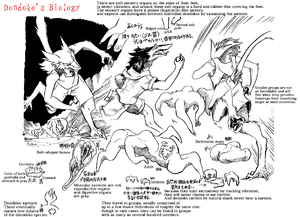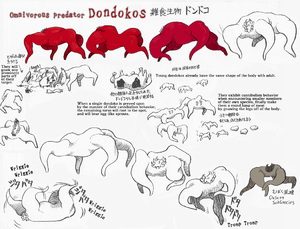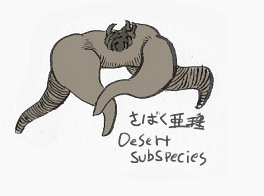Dondokos: Difference between revisions
No edit summary |
No edit summary |
||
| (One intermediate revision by the same user not shown) | |||
| Line 6: | Line 6: | ||
== '''Biology''' == | == '''Biology''' == | ||
[[File:Dondoko ref.png|thumb|300px|Dondoko, an omnivorous predator.]] | [[File:Dondoko ref.png|thumb|300px|Reference and concept art for Dondoko, an omnivorous predator.]] | ||
Their bodies consist of red muscular systems, belt-shaped bones, gray reproductive organs, and digestive organs. While they have gray blood as many Talyxian organisms do, a fraction of their body parts and organs contain bodily fluids in colors of white or orange as well. Their skeletal and muscular structures are arranged in such a way to grant them high mobility. | Their bodies consist of red muscular systems, belt-shaped bones, gray reproductive organs, and digestive organs. While they have gray blood as many Talyxian organisms do, a fraction of their body parts and organs contain bodily fluids in colors of white or orange as well. Their skeletal and muscular structures are arranged in such a way to grant them high mobility. | ||
| Line 36: | Line 36: | ||
<span style="color:#FF0000;">'''[Note]'''</span> ''Earlier it may have appeared in concept art that a desert dondoko has its mouthparts on the rear side of the creature, compared to a common red species that has its mouth on the front of the body. However, both of them actually have their mouths located in the same position. The desert subspecies seen in the artwork is actually facing the front. To solve this, we have edited the layout of the artwork.'' | <span style="color:#FF0000;">'''[Note]'''</span> ''Earlier it may have appeared in concept art that a desert dondoko has its mouthparts on the rear side of the creature, compared to a common red species that has its mouth on the front of the body. However, both of them actually have their mouths located in the same position. The desert subspecies seen in the artwork is actually facing the front. To solve this, we have edited the layout of the artwork.'' | ||
As many of the desert-inhabiting Talyxian organisms appear biologically similar in nature to Eltus shellfish, this dondoko subspecies is no exception. Their skin is thicker than the regular dondoko species, has a structure which is less likely to lose moisture and is less vulnerable to sunlight. Also, they generally have a smaller body and do not form large-scaled groups. | As many of the desert-inhabiting [[Talyxian]] organisms appear biologically similar in nature to [[Eltus]] shellfish, this dondoko subspecies is no exception. Their skin is thicker than the regular dondoko species, has a structure which is less likely to lose moisture and is less vulnerable to sunlight. Also, they generally have a smaller body and do not form large-scaled groups. | ||
Their nature is generally considered milder when compared with their regular counterparts. However, this does not mean they do not possess any less hostility towards the Eltus People, as they still retain their ecological trait, the ability to detect vibrations and rush towards the point of origins in order to catch and maim prey. Due to this, travelers working in small groups of people still need to beware the threat of this dondoko subspecies. | Their nature is generally considered milder when compared with their regular counterparts. However, this does not mean they do not possess any less hostility towards the Eltus People, as they still retain their ecological trait, the ability to detect vibrations and rush towards the point of origins in order to catch and maim prey. Due to this, travelers working in small groups of people still need to beware the threat of this dondoko subspecies. | ||
Latest revision as of 16:27, 18 June 2019
Dondokos (ドンドコ dondoko) are a species which belongs to the Talyxian organism group. They are the most well-known wildlife on Planet Tal, found everywhere on the planet. There are a few subspecies living in the desert zone.
Due to their ecology and nature, they are generally known as a very hostile and harmful creature against Eltus people. Meanwhile, due to their tasty meat and large population, they are also known as a popular edible creature.
Biology
Their bodies consist of red muscular systems, belt-shaped bones, gray reproductive organs, and digestive organs. While they have gray blood as many Talyxian organisms do, a fraction of their body parts and organs contain bodily fluids in colors of white or orange as well. Their skeletal and muscular structures are arranged in such a way to grant them high mobility.
Their longitudinal (horizontally jointed) mandibles show that there are specific front and back to their head and body, but they can run in any direction with their legs, regardless of the direction they face. They are found in sizes as small as 1 foot 9 inches and can grow as large as 9 feet 8 inches in length.
Their running speed is similar to that of most Eltus races, but they can continue running for hours thanks to their abundant stamina.
They eat meat, attacking prey by biting off chunks with their toothy mouths. These mouths also serve as a waste vent, the function of use being divided by a valve. Ingested foods will travel through their stomachs clockwise, in the digestive organs and return to the mouth opening, to be excreted.
There are soft sensory organs on the soles of their feet, to detect vibration, and around these soft organs is a hard and rubber-like covering. The sensory organs have a unique fingerprint-like pattern, and experts can distinguish between individual dondokos by examining the pattern.
Ecology

Dondokos are completely omnivorous, and they will hunt anything if they detect movement vibrations nearby. Especially strong aggression is triggered in these hunters when they notice vibrations that differ from their own, usually caused by creatures who are differently sized than themselves (however, because they hunt exclusively by tracking vibration, they are not scavengers and will never choose to eat carrion). They have a lack of developed senses, relying instead on predatory instincts. They are quite prone to cannibalism, the mere notice of vibrations from another dondoko being enough to trigger a frenzy. They travel in groups, usually comprised of up to a few dozen individuals of roughly the same size, though in rare cases, they can be found in groups with as many as several hundred members. All dondokos reproduce by the method of parthenogenesis.
They are very sensitive to vibration, and will take advantage of their high stamina to run long distances, tracking and chasing their enemy or prey until it no longer has the strength to continue fleeing. As a group, they will gnaw any prominent parts off of their target, finally making it a round lump of meat. They also exhibit this behavior when encountering smaller members of their own species, by gnawing the legs off of the body.
This behavior of cannibalism helps to function as their reproduction system. When a single dondoko is preyed upon in this manner, the remaining torso will root to the spot, and will bear egg-like sprouts. These eventually mature into infants of the donodoko species. After some time, the infant dondokos will form a small group, but there are high mortality rates during their infancy due to rapid growth and blind cannibalism. In contrast with the infants, mature individuals grow more slowly and can form larger groups.
Do note, dondokos, like most Talyxians, are meant to hunt other Talyxians. If they chance upon an Eltus, they may chase and hunt, but their natural prey are the Talyxian creatures that live around them.
Desert Subspecies
There is a subspecies of dondoko that dwells in desert areas, which has a different appearance and ecology from the regular type. This subspecies has a muscular system tinted in colors which range from ochre to yellowish gray while the regular members of the species have red muscles.
[Note] Earlier it may have appeared in concept art that a desert dondoko has its mouthparts on the rear side of the creature, compared to a common red species that has its mouth on the front of the body. However, both of them actually have their mouths located in the same position. The desert subspecies seen in the artwork is actually facing the front. To solve this, we have edited the layout of the artwork.
As many of the desert-inhabiting Talyxian organisms appear biologically similar in nature to Eltus shellfish, this dondoko subspecies is no exception. Their skin is thicker than the regular dondoko species, has a structure which is less likely to lose moisture and is less vulnerable to sunlight. Also, they generally have a smaller body and do not form large-scaled groups.
Their nature is generally considered milder when compared with their regular counterparts. However, this does not mean they do not possess any less hostility towards the Eltus People, as they still retain their ecological trait, the ability to detect vibrations and rush towards the point of origins in order to catch and maim prey. Due to this, travelers working in small groups of people still need to beware the threat of this dondoko subspecies.
Relation with Eltus people
While dondokos are treated as terrible and harmful creatures, the Eltus people also identify them as a common food source. Almost the entire body can be eaten, and their meat is healthy and flavorful. Thanks to their taste and the presence of dondokos in most of Tal's various ecosystems, dondoko meat is a staple food in almost all areas inhabited by the Eltus races.
Smaller groups are not as formidable and will flee when they perceive footsteps from something larger or more numerous. But they become more aggressive as they grow larger, or as their groups gain more members. The large individuals or large groups (even composed of small individuals) are especially dangerous.
They mainly react to footstep-like vibrations, so thankfully there are some safe methods to move near them, including crawling on the ground like a leech, vaulting from cliffs, or riding a wheeled vehicle. To these non-footstep vibrations, they are not usually attracted or aggressive. Because of this, people usually use cars for safe transport in dondoko-inhabited areas. Another option to avoid detection is to hide in a tree until the swarm moves on.
Though the sensory perception of dondokos is very limited, as a group increases in size, the collective dondokos become more sensitive to heterogeneous sources of vibration (such as those caused by Eltus traveling on foot). This only makes them more likely to attack. Lots of large vehicles often indicate the nearby presence of a large group of dondokos, and can signal an area as being dangerous. Thankfully, these dangerous areas are easy to identify, with the sight of many vehicles traveling to avoid such groups of dondokos. Large vehicles are the safest way to travel through the dondoko areas, since the vibrations caused by wheels do not trigger the dondoko attack instincts.
Useful Links
Start Vilous!
Enjoy the Stories!
Peek at the World!
Terms of Service

